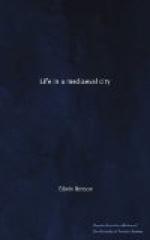D. RELIGIOUS LIFE
[Illustration: ADMINISTERING HOLY COMMUNION WITH THE HOUSEL CLOTH. From a Fourteenth-Century Manuscript.]
Insistence can hardly be too great on the tremendous and wide-spread influence of the Church in the Middle Ages. The greatness of the Church continued during the fifteenth century; it derived from the traditions of an age when absolute power prevailed, from the undisputed usage of centuries, from a logical system of dogmas, and from international sanctions. The ornate services, allegiance to the distant Pope, the immense hold of the priests on the laity, the large territorial possessions of ecclesiastical bodies, impressed the people with the power of the Church. These things came to the fifteenth century as established facts. The spirit of revolt indeed had appeared with Wiclif and his followers in the fourteenth century, but Lollardy met with severe repressive opposition. It was not till Tudor times that the new spirit, stimulated by the Revival of Learning, the Reformation, the invention of printing from type, geographical discovery, the suppression of long years of internecine warfare, and the establishment of a strong government, had accumulated enough energy to burst the bonds of mediaevalism. The fifteenth century was at the end of an age.
It is interesting to note that Wiclif (d. 1384), one of England’s greatest men, was ordained in York. He stands out as a “daring and inspired pioneer” who strove to provide the land with priests who were true and earnest shepherds. He attempted the superhuman task of reviving true religion among a people that had become to a certain extent dull, irreverent, ignorant, and thoroughly superstitious.
By the fifteenth century the Church was suffering from those ills which needed and later gained drastic treatment. The Church had done almost miraculous work in the first few centuries of its existence, if we think only of the success with which it substituted its system of morality for that of pagan Rome. The fifteenth century followed those centuries when the Church of England, under the direction of great and earnest men, was doing its work with conspicuous success. Yet, the very forces that enabled the Church to make itself a living power in the Dark Ages, the early centuries embracing the Fall of Rome, the Empire of Charlemagne, and the kingship of Alfred the Great, became harmful to its continued activity beneficially in many directions. The inadequacy of its work in these centuries appears in the lack of spiritual activity and in the predominance of the material side of religion. The mediaeval Church suffered badly from excessive conservatism, which led towards sloth and a complacent inactivity. The morbid element showed itself during the fifteenth century mainly in lack of real earnestness, in the enjoyment of luxurious laziness, and in the steady neglect of the age to




